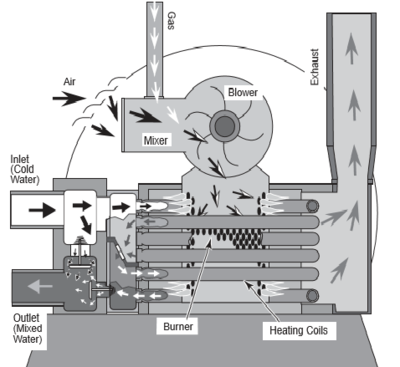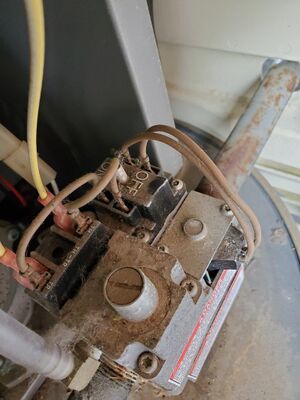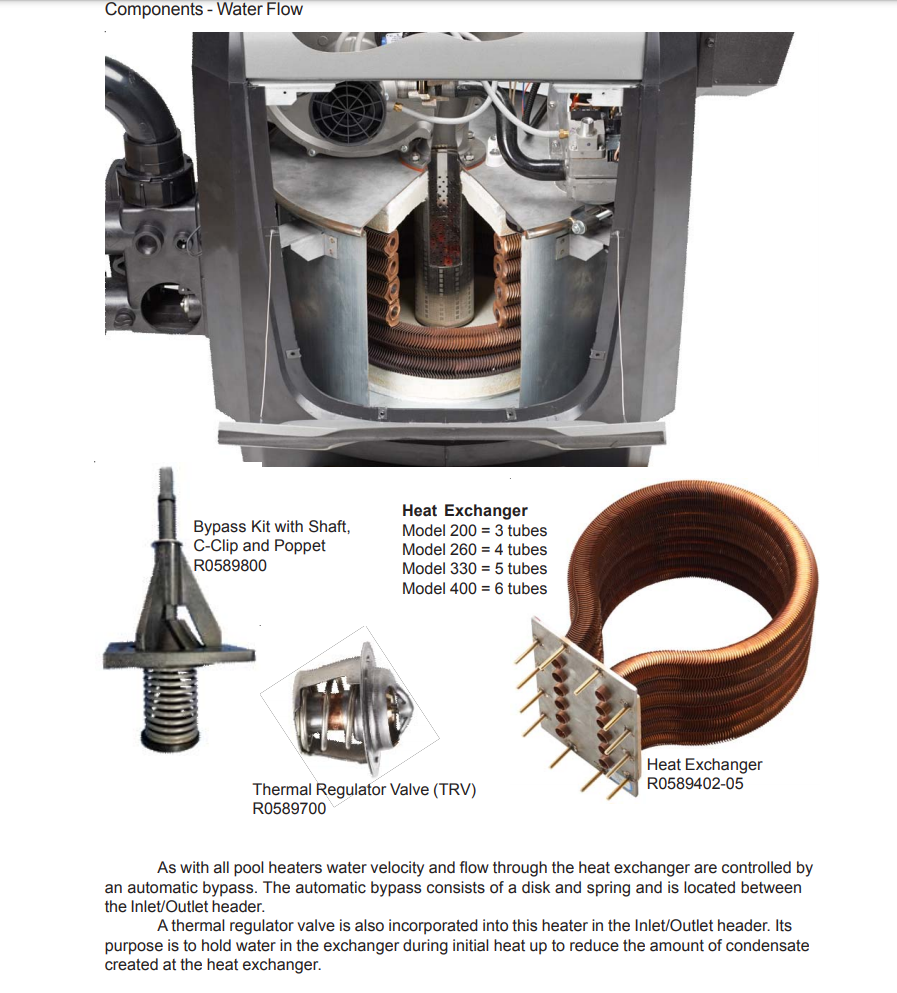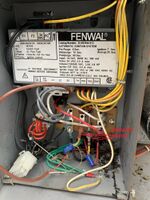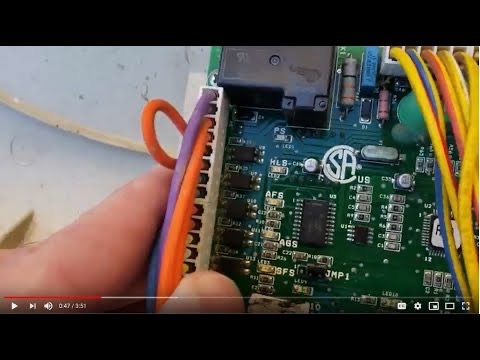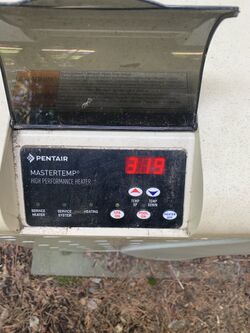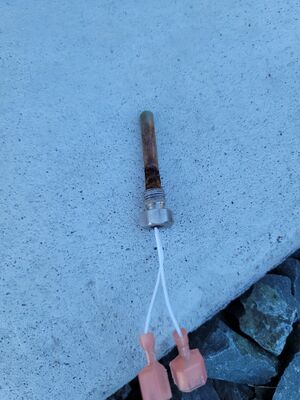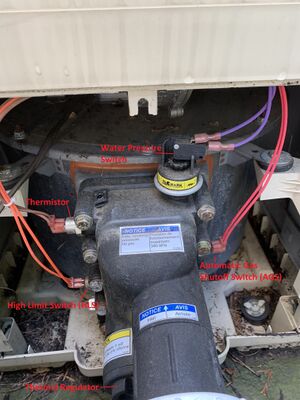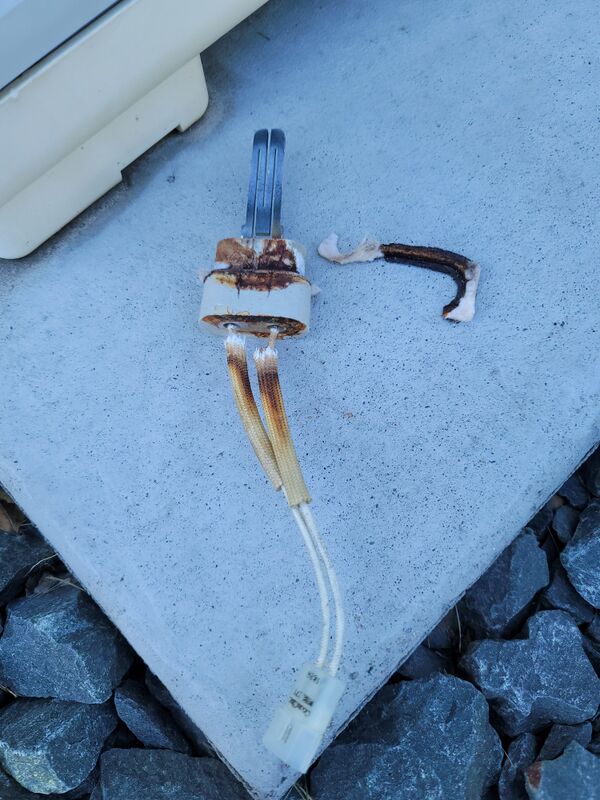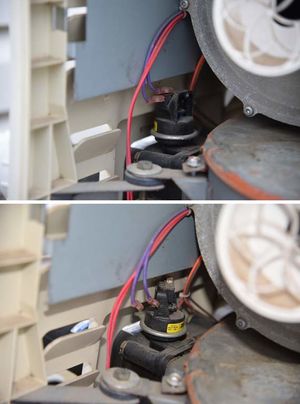| Line 270: | Line 270: | ||
==Repairs== | ==Repairs== | ||
| − | Parts diagrams including replacement part numbers are at | + | Parts diagrams including replacement part numbers are at [https://www.pentair.com/content/dam/extranet/nam/pentair-pool/residential/parts-sheets/product-catalog-parts/pool-heaters-parts.pdf HEATERS & HEAT PUMPS PARTS Product Catalog 2021] |
| − | |||
| − | [https://www.pentair.com/content/dam/extranet/ | ||
| − | |||
| − | |||
| − | |||
| − | |||
===Thermal Regulator=== | ===Thermal Regulator=== | ||
Revision as of 21:05, 1 November 2021
Pentair MasterTemp Heaters
The Mastertemp heater is a re-packaged Sta-Rite Max-E-Therm heater. Sta-Rite introduced those heaters into the market prior to them being bought by Pentair. Then Pentair immediately put the heater into their "cube" design and began selling the heaters both ways. The Max-E-Therm is still in production under the Sta-Rite name.
Pentair has a regular residential mode MasterTemp heater and a commercial ASME certified performance model[1] MasterTemp heater.
The commercial ASME certified performance model features include:[2]
- New bronze header design for easy access to the thermal regulator and bypass valve service without use of special tools
- Upgrades to thermal regulator include a governing stainless steel sleeve for better wear protection
- All internal components of the bronze header are plastic for lightweight, corrosion and wear protection
- Ignition Control Module includes more diaphragm spring force for better gas control and robust operation.
- Fuller pre-mixed system with highly efficient air and gas mixture allows for faster heat up times
- Efficiencies up to 84%
Both the MasterTemp and MasterTemp ASME come in an HD model that has a cupro-nickel exchanger. Pentair claims the cupro-nickel exchanger stands up to the harshest of applications, like low pH, high flow or heavy use.[3]
The MasterTemp heater is a compact, lightweight, efficient, induced-draft, gas fired high performance pool and spa heater that can be directly connected to schedule 40 PVC pipe. The MasterTemp heater also comes equipped with the Pentair multifunction temperature controller which shows, at a glance, the proper functioning of the heater. All MasterTemp heaters are designed with a direct ignition device, HSI (hot-surface ignition), which eliminates the need for a standing pilot. The MasterTemp heater requires an external power source (120/240 VAC 60 Hz) to operate.[4]
MasterTemp Gas Heater versus UltraTemp Heat Pump
UltraTemp Heat Pumps and MasterTemp Gas Heaters are very different technologies.[5]
Heat pump technology is the most efficient way to heat a pool, however, the lower BTU rating of heat pumps means that it can take longer to heat the pool to a desired temperature. Heat pumps also have reduced heating performance when the ambient air temps are very low (when ambient temp drops below about 50F.) This is because heat pumps do not make heat; they simply capture the free heat from the air and move it into the water. Heat pumps are typically sized from 70,000 BTU to 140,000 BTU.
Gas heaters work well in all ambient air temps, and they have higher BTU output (commonly up to 400,000 BTU.) Gas heaters are great if you want to heat water up quickly in all weather conditions, but a gas heater is much less efficient than a heat pump.
The US Dept of Energy has some good, unbiased articles about choosing the right kind of pool heating equipment for your needs - Swimming Pool Heating
Here’s a blog article from pool equipment retailer In The Swim that sums it up fairly well, especially the comparison table and the two lists of “best choice” points, located about halfway down the page - Pool Heaters: Heat Pumps vs. Gas Pool Heaters | InTheSwim Pool Blog
Heater Description
Precisely matched orifice plates meter the air and gas into the mixer. The blower draws the air and gas through the mixer and forces it into the burner’s flame holder. A sealed heat exchanger surrounds the flame holder, discharging exhaust gases out the flue.
Two inch PVC water piping connects directly to the manifold/header on the heat exchanger using 2" PVC slip unions provided with the heater. The outer manifold remains cool; no heat sinks are required. A thermal regulator and an internal bypass regulate the water flow through the heat exchanger to maintain the correct outlet temperature. The heater operator control panel board assembly is located on top of the heater.
Sequence of Operation
Normal boot up is 888, 128 and then rX where X is the software revision number.
An electronic temperature sensing thermistor in the manifold adapter inlet controls the heater operation. When the inlet water temperature drops below the temperature set on the operating control, the burner controller supplies power to the combustion air blower through a series of safety interlocks. The interlocks consist of:
- the pressure switch (PS), which senses that the pump is running,
- the high limit switch (HLS), which opens if the heat exchanger outlet temperature goes above 135° F (57° C), and
- the air flow switch (AFS), which senses the pressure drop across the air metering orifice,
- the automatic gas shut-off (AGS) switch, which opens if the heat exchanger outlet temperature goes above 140° F (60° C).
- the stack flue sensor (SFS), which shuts down the heater if the flue gas temperature reaches 480° F (249° C).
The air flow switch (AFS) senses the pressure drop across the air metering orifice. As soon as there is sufficient air flow, the AFS closes, closing the circuit to the hot surface igniter (HSI), which ignites the fuel mixture. On a call for heat, the blower and HSI are energized. In about 20 seconds, the gas valve opens and ignition occurs. The HSI then switches to a sensing mode and monitors the flame.
The heater is equipped with a digital operating control that enables the user to pre-set the desired pool and spa water temperatures. The control enables the user to select between pool and spa heating, and features a digital display that indicates the water temperature.
The Jandy JXi is the same type of design.
The blower pushes the air gas mixture into the flame holder inside the combustion chamber.
Installation
Heater Bypass
A manual heater bypass allows the heater to be taken out of the water loop for maintenance or if there are concerns about the water quality such as low pH that can damage the heat exchanger.
Pentair recommends a manual bypass when the water flow rate exceeds the maximum 120 GPM. After installing the valve, adjust the valve to bring the flow rate within the acceptable range. Then remove the valve handle or lock it in place to avoid tampering. See page 13 of the Installation Manual
Heater Cooldown
The filter pump should run continuously when the heater is on, and for at least 5 minutes after the heater turns off. Any switches in the pump circuit (including circuit breakers) that can disconnect the pump must also disconnect the heater. See page 29 of the Installation Manual
A time clock controlling the filter pump should have a low-voltage Fireman’s Switch that switches off the heater at least 15 minutes before shutting off the pump.
Firemans Switch
The "Fireman's Switch" is a poor name for the 2 wire 24 volt AC remote control system of the heater. The Fireman's Switch is a 2 wire control that can connect to automation such as the EasyTouch or IntelliCenter or to a timer. The current is less than 500 milliamps (0.5 amps).
The firemans switch is the two center bottom terminals with the yellow wires on the block below the Fenwal box. The right terminal has the fuse. You remove the jumper and run a wire from one fireman's switch terminal to the one connection of the J19 terminal in Easytouch and then a wire from the other J19 terminal back to the other fireman's switch terminal or similar connections in other automation controllers.
- IntelliCenter: Insert the conductors into the GAS HEATER two-screw terminals (J2) on the upper right of the mother board.
- EasyTouch Control System: Insert the conductors into the GAS HEATER two-screw terminals (J19) on the motherboard.
- IntelliTouch Control Personality circuit board: Insert the two conductors into the GAS HEATER (J30) two-screw terminal on the left side of the Personality circuit board.
The blower will continue to run for about 45 seconds after the burner shuts off.[6]
RS-485 Remote Control
Any MasterTemp heater with a manufacture date after May 15, 2021, and has a "6-button" membrane keypad (with a MENU button), then those MasterTemp heaters DO have RS-485 capability built in.[7]
While the manual says the MasterTemp can connect to Pentair control systems via a 3 wire RS-485 connection the connector is not on older boards. See pages 37-40 of the Installation Manual
MasterTemp RS-485 Combo Conversion/Replacement Kit
This kit is an unreleased bundle that includes all 4 parts that would be required to convert an older MasterTemp to have the newer RS-485 features that Pentair introduced as a running change this year.
The kit that will be released in a single bundle sometime in the future contains the following items. All of these items can be purchased separately now.
- Wiring Harness
- Ignition Control Module
- Control Board
- Membrane Keypad
Pentair does currently sell each of the four parts individually (a la carte), but the bundle kit is not released yet.
Although converting an older MasterTemp to RS-485 is technically possible, it is highly discouraged and here is why. One of the required steps would be to replace the whole wiring harness inside the heater, which would take a really long time as it requires removing and replacing every single wire connection at every terminal, every sensor, every connection point to include the ignition control module, control board and the membrane keypad. Pentair says that it would take even a seasoned pool professional a long time to complete the job…
Pentair said that in the future, they plan to release a kit that includes all four of those parts in a single bundle. At that point, a person could upgrade an older heater by buying the kit/bundle of four parts (they would order one part number and receive one box that contains all four parts.)[8]
Theoretically, you could today order part #1 & #2 & #3 & #4 individually (you would order four separate part numbers and get four separate boxes) and accomplish the same thing, but Pentair expects very few people to go through the trouble of taking apart an older heater to install all four parts just for the sake of doing an elective upgrade, which is why the four part kit/bundle remains unreleased.
Changing the display between Centigrade (°C) and Fahrenheit (°F)
To toggle the display between degrees Centigrade (°C) and degrees Fahrenheit (°F):
- Turn the Operating Control OFF.
- Press ^TEMP or down TEMP for 5 seconds. The display will flash once and change modes (°C to °F or vice versa).
- Turn the Operating Control ON.
When either the ^TEMP or down TEMP buttons are depressed, the digital display will indicate the temperature setting.
After five seconds, the display will return to the actual pool/spa temperature.
Maximum Temperature Set Point
The heater comes factory set with a maximum temperature set point at 78° F (25.6 c). for the pool mode and 100° F (37.8 C). The Installation Manual describes how to increase the maximum temperature set point of the pool and spa. It involves unbolting and removing the door panels, accessing the control panel board on the underside of the top cover, and locating the yellow button on the corner of the control board.
Altitude Adjustments
Air is thinner and less dense as the altitude increases. A natural gas or propane heater needs an optimum mixture of air and gas. If the air/gas mixture is incorrect you will have an orange yellow flame instead of a good blue flame.
At higher latitudes the gas needs to be adjusted for the proper air/gas mixture.[9] The Pentair Mastertemp is good to 9,000 feet.
What Do the Diagnostic LEDs Mean on the Pentair MasterTemp?
Diagnostic LEDs are on the back of the Pentair MasterTemp heater board.[10]
The following are the LEDs:
- .....PS (Pressure Switch)
- .....HLS (High Limit Switch)
- .....SFS (Stack Flue Sensor)
- .....AFS (Air Flow Switch)
- .....AGS (Automatic Gas Shutoff).
- .....Service System
- .....Thermistor
- .....Heating
- .....Pool On
- ...Spa On
- ...Service Heater.
HLS (High Limit Switch) Error
The HLS is often caused by lack of sufficient water flow through the heat exchanger. This can be due to several things:
- Thermal regulator not opening.
- External bypass open.
- Internal bypass broken.
- Pump too small or on too low rpm.
- Clogged filter.
- Scale in heat exchanger.
Start by checking the thermal regulator.
E05/E06/SFS (Stack Flue Sensor) Error
E05 errors are due to things like a sooted exchanger(fuel delivery, venting), scaled up exchanger (water side), or a low water flow.[11]
E05 and E06 are more or less the same thing. Problem with the Stack Flue Sensor.[12]
You can get an E05(open sensor) if a rat chews through the wire(s). An E06 is a shorted sensor, or if the board thinks it is a switch, and not a thermistor (didn't get programmed when it was installed).
If you hold down POOL or SPA button for at least 10 seconds it displays the exhaust temp. Normal temps should be ~290-350.
Turn the heater on. The fan will come on for about 30 seconds, then you will hear a click, and the heater should fire. At that moment, which ever thermostat you are using (POOL or SPA) hold that button down for ~10 seconds. Display should change from water temp to exhaust temp. Normal temps should be in the range of 290-350. 350-500 is considered high and you should look for:[13]
- Sooted exchanger(external) due to improper gas pressure or lack of proper venting. either supply of fresh air or exhaust, or both. Heater is being starved of air and the resulting air/fuel mix is too rich (fat).
- Calcified exchanger (internal) due to improper water chemistry. Note: Not necessarily right now, but at some point in the past, and for a while. This does not happen overnight.
- Flow or velocity issue. Water is moving too slowly through the exchanger, gathering or absorbing too much heat, and is not carrying it away quickly enough to keep the heater at a workable temp. In this case, you may have a valve closed down, but not fully closed, or may be wanting to save a little more money on your electricity bill, so you turned down your VS pump as low as you can get away with. You will need to turn it back up to correct this !
Check the interior for obstructed venting (intake and exhaust). Animal nests, spiders, mud dauber nests against the air blower vent, can all block the air flow and lead to an overheat and SFS error.
You see those problems a lot more then a sensor that has gone bad. Although continued high temps could eventually cause a SFS to fail. The SFS will let the heater stack temp to run up to 480 degrees before it will shut the heater down. In the case of a sooted exchanger, the stack flue temp would rise slowly over time (weeks/ months) subjecting the sensor to extended over temp conditions.
The sensor may be tested with an ohm meter (3.8 MegOhms @ 77F) If you decide to get a new SFS, check the stack flue temp when you get it back together and running to confirm that the stack flue temps are where they should be, and not too high.
The part number for the Stack Flue Sensor is Pentair 42002-0024S
AGS Error
- Remove the leads from the AGS sensor and connect them together. Temp only for the test.
- Then, check the continuity of the sensor. It should be closed.
- Start the heater. If the sensor opens, immediately turn off the heater.
- If the sensor opens, it might be a bad sensor or the water is overheating.
- To test the sensor, put it in hot water to see where it actually opens.
- If the sensor does not open and the heater shuts off with an AGS light, the board is bad.
Refer to to pages 31 and 32 of the Installation Manual[14] the connection and ladder diagrams. You will notice that all of the safeties and gas valve are run through the operating control and ignition module.
You should first have 24 volts ungrounded to IND on the ignition module through water pressure switch and hi limit to start the inducer (blower) motor which will then make the air flow switch to put 24 volts ungrounded to the TH (W on some) terminal on the ignition module. This should start the ignition trial.[15]
After the igniter warm up time the ignition module powers the gas valve through VAL on the ignition module, but this also goes through the operating control VAL which then goes through the AGS safety to the gas valve. This is your ignition module Fenwal 35-662944-013 and it is user specifically modified which is why you don't see a W terminal.
You should notice on the ladder diagram that one leg of the 24 volt side is grounded. Right after the heater fires up, if you add a jumper from the ignition module VAL terminal to the TH terminal on the gas valve and the heater keeps firing then the problem is either with the AGS switch or the operating control. If it still shuts down then the problem is with flame sensing.
AFS Error
AFS is the air flow switch that senses if the blower is on and there is sufficient air flow to the burner. Sequence is blower motor should turn on, AFS senses air flow through a white tube down by the burner can, and switch closes to start the ignition sequence.
You can gently blow into the white tube and you should hear the click of the air flow switch turning on. Check the white tube for cracks or breaks. The white tube is not available as a separate part and comes with the Pentair MasterTemp & Sta-Rite Max-E-Therm Air Flow Switch assembly P/N 42001-0061S.
If you hear the air flow switch closing then check the continuity of the air flow switch relay using a multimeter. Connect the multimeter to the two contacts on the air flow switch after removing the heater wires. You should see it electrically open when no air is blown into the switch and closed when air pressure is through the tube.
Testing the Air Blower
Check that the blower motor rotates freely before doing electrical checks. Sometimes the blower has began running by simply cleaning debris from the fan area or removing the cover to the blower motor and using a screwdriver to manually turn it.
Note: No guarantees on anything. Only do what you know that you can do safely. Do at your own risk.
The blower has 3 sets of windings.[16] 2 main run windings and an auxiliary start winding. Red and blue go to one set of windings. Black and yellow go to the other set.
- For 120 volts, the windings are in parallel.
- For 240 volts, the windings are in series.
The auxiliary start winding is in parallel with the black --> yellow winding.
Remove the capacitor and test for resistance from red to blue and black to yellow. The values should be the same.
- Label the capacitor wires C1 and C2.
- Test from C1 to C2, C1 to black, C1 to yellow and C1 to white.
- Test from C2 to black, C2 to yellow and C2 to white.
Test from each wire to the green ground wire to see if any wires are shorted to ground.
Check the power going to the blower[17]:
- When the heater tries to start, you should be seeing 240 volts from red to black on the wires going to the blower.
- You can disconnect the blower plug and test the power at the red and black wires.
- Have the meter connected because the power might shut off after a few seconds.
- The red should be powered any time the heater is powered.
- So, you should get 120 volts on that leg before the heater tries to start.
- The black wire doesn't get power until the blower is supposed to be on. When the heater tries to start, power is applied to black and you should get 240 from red to black.
To test the motor directly wire as follows:
- For 240 volts, Black to hot leg, Red to the other hot leg, blue and yellow connected together.
- For 120 volts, red and yellow to one line, black and blue to the other line.
- The white wire is connected to the black wire, so cap it off when applying power to the black wire so that it doesn't make contact with anything.
If the power test shows that the motor is good, the problem is likely to be with the ignition control module or the main board.
Note: the above is believed to be correct. It's presented as is. If you want to test like this, you do it at your own risk.
Do the resistance test first as that should tell you something.
Test the capacitance of the capacitor to make sure that it's correct.
One power leg is always connected to the blower motor and the black wire from F2 is the switched leg.
Exhaust Gas Temperature
While running, press and hold the On button will display the exhaust temperature display.
Here is what the normal exhaust temperature should be:
- Below 250 degrees...very low
- 250 to 290 ..................low
- 290 to 350.................acceptable
- 350 to 480 ..................high
- Above 480...................error/shutdown.
Note: HD models can be up to 75 degrees higher. HD models use a cupro nickel exchanger and the efficiency is slightly lower resulting in less heat transfer and more waste heat.
If the exhaust gas temperature is higher then normal then water may be bypassing the heat exchanger through a broken bypass valve.
If you hold down the "pool on" button, it stays on 80, then flashes to 40, then back to 80, then the 80/40 reading and E05 indicate that the board is not getting a reading from the sensor. It's usually a bad sensor or damaged wires.
Repairs
Parts diagrams including replacement part numbers are at HEATERS & HEAT PUMPS PARTS Product Catalog 2021
Thermal Regulator
The thermal regulator is behind a screw off cap between the in/out pipes in the heaters header. With the pump off, unscrew the cap and pull the regulator out. Note, if the regulator does not come out easily and feels like it hung up on something, then the bypass is broken and hanging in the way. If it comes out with no issues I'm sure you find it's all gunked up. Then use you fingers and stick them in the opening and feel up around towards the top middle and you should feel a round button like item, that's the bypass. If you feel it and it seems to be solid, then you are good with that.[18]
To test the thermal regulator Put it in hot water (130 to 140 F) to see if it opens.
The thermal regulator is sensitive to water chemistry and can get erosion.
Bypass Valve
If the bypass valve is broken the heater will short cycle and make noise. If you look in the hole where the thermal regulator goes, you should be able to see the black disk. If you look in the water inlet, you should be able to see the spring.
You will have to take the manifold off to replace the Internal by-pass kit P/N 77707-0001.
Guide to replacing the bypass valve is for the residential MasterTemp model.
The ASME commercial MasterTemp model has a different manifold with a 2-inch Pipe Plug, (for access to Internal BypassValve), located at the top of the Manifold.[19]
Bad Temperature Sensor
- The "E01" code is an indication of an open water temperature sensor that is also called the thermistor on the parts diagram.
- Problem - Heat will not fire, blower does not even turn... heat is set at 89*. membrane is showing water temp 107... easy touch panel temp reading is accurate (thermometer in pool 83*).[20]
- Thermistor p/n 42001-0053S Part 7 on page 54 of the MasterTemp Installation manual[21].
Blower not Operating
Listen closely when you turn the heater on, after it cycles through the 888, 128, R13. You may need to put your ear right next to the top of the heater (where the board is) to hear if the small relay on the board clicks (May sound more like a "tick" than a "click"), giving voltage to the blower. This click will be more subtle than the click you normally hear when the gas valve opens (you wont hear that one though if the blower never starts).[22]
If you can hear the click, look at the blower. No click, look at the board. If you are getting the AFS error, that means the safety switches have been satisfied, and the board should be telling the blower to start (power to relay coil).
Bad Igniter
If the blower starts, the attempt to light the flame starts, you smell gas, here the click, then it sounds like something closes. Repeats a couple times and throws the 3 blinks of the led on Fenwal box then you may have a bad igniter.
With a bad igniter you do not hear the woosh of the flame lighting and feel a burst of hot exhaust before it shuts down.
You can do some diagnostics on it and see if it is heating, examine it visually, check the resistance of it which should be 50 ohms, and check there is 120V AC going to the igniter when the heater starts.
A new igniter resistance is 50 ohms.
Below is an igniter that was removed from a MasterTemp heater where the flame would light but then shutdown due to a flame sense error.
It is interesting to note that the igniter corrosion also occasionally caused the GFCI CB to trip when the heater lit.
Flame Rectification Failure
Does the heater briefly ignite and you get a puff of heat and then shuts down? If so you may have have a flame sensing problem. Heater Flame Sensing describes what may be happening and ways to fix it.
Replacing Wiring
Wiring can get chewed up by critters.
If any of the original wiring supplied with this heater must be replaced, installer must supply (No. 18 AWG, 600V, 105° C. U.L. approved AWM low energy stranded) copper wire or it’s equivalent.
Line voltage field wiring should be 14 gauge, with a circuit capacity of 15 Amps.
Replacing Transformer
Pentair MasterTemp transformer P/N is 42007-0107. P/N 42007-0107s is for units made after 2003.
A bad transformer can cause the fuse to blow.
Main Board
Control Board Kit (NA, LP Series) part number is 42002-0007S.
Pentair Membrane Key Pad Replacement
The membrane keypad sometimes fails and is separately replaceable with Pentair part number 472610Z.
Winterizing
Removing Water Pressure Switch
One of the winterizing steps in the manual is to remove the water pressure switch.[23]
Gain access to the heater by removing the two panels and locate the water pressure switch. Disconnect the two electrical leads and rotate the switch counterclockwise.
You may find the switch terminals hit the frame hits is the main body panel of the heater. You have to remove the side panel as well. The panel does come off.
Air Intake
Seal up the air intake with some plastic while in there.
Rat Proofing the Heater
Rats climb in through the air vents and nest in the heaters over the winter. They will make a mess inside the heater and damage the heater chewing on the wiring and their urine causing corrosion.
Rats and mice often make their home in the electrical box and chew up the wiring. You can repair the wire harness from any chewed damage.
You should check the blower rotates freely and may need to take the blower motor off and clean that out probably.
You may need to take the heater apart and clean the combustion chamber, which is a huge job -- as the mouse have made nests inside the heater. This messes up the ignition and the air flow.
MK Rat Proofing sells wire mesh kits to cover the vents or you can fabricate your own using 1/4" mesh wire screen or simple chicken wire and some sheet metal.
Some people put mothballs inside the unit to keep mice out.
Tips
- After start-up, the outlet water pipe should feel slightly warmer than the inlet pipe. If it feels hot, or if you hear the water in the heater boiling, there may not be enough water flow to the appliance. Make sure that the filter is not plugged. If water temperature remains high but the unit continues to operate, turn off the appliance and call your service technician.
- Operating this heater continuously at water temperatures below 68° F. (20° C) will cause harmful condensation and will damage the heater and void the warranty.
- When starting the heater for the swimming season with a water temperature below 50° F (10° C), the heater may be used to heat the water; however, make sure that the heater operates continuously until the water temperature reaches the heater’s minimum setting of 68° F (20° C).
- During cold weather, if there is no danger of freezing, operate the filter pump continuously even if the heater is not operating. If air temperatures are expected to drop below freezing (32° F/0° C), shut down the heater and winterize it.
.
- ↑ https://www.pentair.com/content/dam/extranet/aquatics/commercial-pool/literature-and-brochures/brochures/heaters/mastertemp-maxetherm-commercial-heater-brochure-english.pdf
- ↑ https://www.pentair.com/en/products/commercial-pool-spa-equipment/pool-heaters/mastertemp--high-performance-asme--certified-heaters.html
- ↑ https://www.pentair.com/en/products/pool-spa-equipment/pool-heaters/mastertemp_heater/sku/460805.html
- ↑ https://www.pentair.com/content/dam/extranet/product-related/product-manuals/pool-and-spa-equipment/mastertemp/MasterTemp_Pool_and_Spa_Heater_Installation_and_Users_Guide_English.pdf
- ↑ https://www.troublefreepool.com/threads/intellicenter-and-mastertemp-400-communication.209684/post-2073090
- ↑ https://www.troublefreepool.com/threads/heater-integration-with-easytouch-and-new-pump.202123/post-1784068
- ↑ https://www.troublefreepool.com/threads/intellicenter-and-mastertemp-400-communication.209684/post-2073090
- ↑ https://www.troublefreepool.com/threads/intellicenter-and-mastertemp-400-communication.209684/post-2074386
- ↑ https://www.troublefreepool.com/threads/gas-pool-heater-and-elevation-altitude.39163/post-327562
- ↑ https://www.troublefreepool.com/threads/mastertemp-400-shutdown-issue-e05-error.193404/post-1704484
- ↑ https://www.troublefreepool.com/threads/pentair-mastertemp-400-error-code-e05.73905/post-1191649
- ↑ https://www.troublefreepool.com/threads/mastertemp-400-e05-error.171793/post-1517990
- ↑ https://www.troublefreepool.com/threads/mastertemp-400-e05-error.171793/post-1514855
- ↑ http://www.pentairpoolme.com/uploads/document/file/554/Manual_MasterTemp.pdf
- ↑ https://www.troublefreepool.com/threads/another-mastertemp-400-with-ags-led-service-heater-led.196702/post-1734928
- ↑ https://www.troublefreepool.com/threads/mastertemp-400-humming-already-replaced-the-run-cap-still-humming.199621/post-1762831
- ↑ https://www.troublefreepool.com/threads/mastertemp-400-humming-already-replaced-the-run-cap-still-humming.199621/post-1765494
- ↑ https://www.troublefreepool.com/threads/pentair-master-temp-400-problems.113128/post-1001404
- ↑ https://www.pentair.com/content/dam/extranet/product-related/product-manuals/pool-and-spa-equipment/mastertemp/MasterTemp_and_Max-E-Therm_Bypass_Access_Plug_Kit_Instructions_ASME_Models_Only_English.pdf
- ↑ https://www.troublefreepool.com/threads/mastertemp-400-ng-bad-board.192416/
- ↑ https://www.pentair.com/content/dam/extranet/pentair-pool/commercial/manuals/heaters/Manual-MasterTemp-472592-English.pdf
- ↑ https://www.troublefreepool.com/threads/mastertemp-400-issue.151028/post-1341812
- ↑ https://www.troublefreepool.com/threads/water-pressure-switch-removal-pentair-heater.153252/post-1355449


